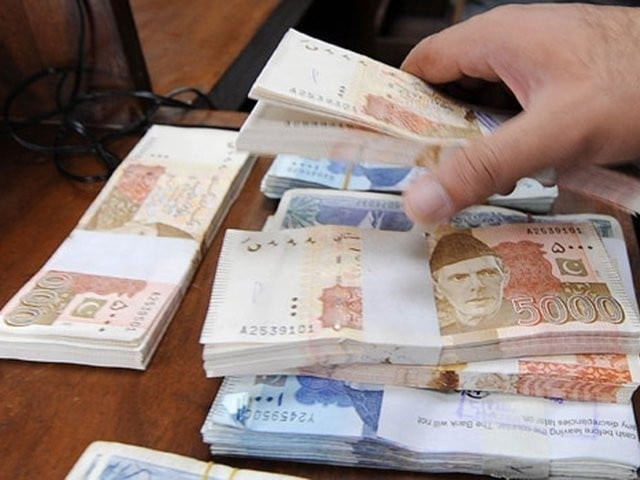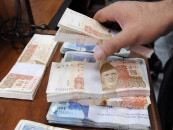Govt borrows a whopping Rs2.24tr in just five months
Overall debt increases to Rs26.5tr due to revenue shortfall, rupee depreciation

Overall debt increases to Rs26.5tr due to revenue shortfall, rupee depreciation.
PHOTO: FILE
From July through November 2018, the federal government on an average added Rs15 billion a day to its debt which included almost three and a half months of the Pakistan Tehreek-e-Insaf (PTI) government, according to figures released by the State Bank of Pakistan (SBP) on Monday.
The data showed that the federal government’s debt taken from the central bank surged at an alarming pace of 87% in five months, standing at a record Rs6.73 trillion at the end of November 2018.
The central government debt figures for July-November 2018 suggest that the finance ministry lacks a credible strategy to deal with the growing public debt. It has been breaching the SBP Act 1956 that requires the retirement of central government debt from the central bank instead of adding to it.
The debt figures also underscore that refinancing and interest rate risks have rapidly grown in the past five months as the federal government’s short-term debt has grown to 58% of the total domestic debt. Overall, the federal government’s debt increased to Rs26.5 trillion, a net addition of Rs2.24 trillion from July through November. It was higher by 9.2% when compared with June 2018 statistics.
The overall increase in the central government debt seems not in line with the budget deficit requirements due to currency depreciation.
The external debt of the central government increased 17% to Rs9.12 trillion in the first five months of the current fiscal year. There was a net increase of Rs1.33 trillion in the external debt due to 15.4% depreciation of the currency from July through November 2018.
In June 2018, the value of a dollar was equal to Rs121.54 which reached Rs140.268 by November 30, according to the central bank.
These figures do not include loans of Rs810 billion taken from the International Monetary Fund (IMF) and loans of $3 billion acquired from China, which are the responsibility of the central bank. It was also not clear whether the SBP has added $1 billion in Saudi loan to the federal government debt which was received in November.
A steep shortfall in tax revenues coupled with uncontrolled spending on debt servicing also added to the debt burden. Latest results suggest that against the finance ministry’s estimates of adding Rs10 trillion to the public debt over the first three years of the PTI government, the actual increase may be far higher than that.
The ballooning public debt remains a concern due to the previous government’s inability to attract non-debt creating inflows and enhance tax revenues. The PTI government has not yet changed the course of the fiscal policy and it is largely implementing the policies followed by the previous Pakistan Muslim League-Nawaz (PML-N) administration.
The SBP’s latest debt bulletin showed that the most worrisome aspect was the continued growth in the short-term domestic debt that exposed the government to refinancing and interest rate risks.
The federal government’s total domestic debt increased to Rs17.32 trillion, an addition of Rs906 billion or 5.5% in five months. The share of short-term public debt increased alarmingly to 58% or Rs10.1 trillion by the end of November. In June last year, the short-term domestic debt stood at 54.1% or Rs8.9 trillion. The short-term debt grew Rs1.2 trillion or 13.2% in five months.
Stagflation likely to hit Pakistan’s economy soon
In the first five months of the current fiscal year, the federal government retired the debt got through market treasury bills (MTBs) from commercial banks. The government’s total borrowing through MTBs decreased from Rs5.3 trillion to Rs3.3 trillion. There was a reduction of almost Rs2 trillion or 37.2% in the government debt from commercial banks in five months. In contrast, the MTBs issued to borrow from the central bank rose to Rs6.74 trillion, a net addition of Rs3.2 trillion or 87% from July through November.
The change in the composition of domestic debt suggests that the government will not meet goals of the second Medium-Term Debt Management Strategy 2016-19 that has been designed to increase the debt maturity profile to reduce refinancing risk.
Upcoming second mini-budget to be defining moment for economy
In contrast to the short-term debt, the country’s long-term debt decreased 3.5% to Rs7.3 trillion. Its share was 46% in the total domestic debt at the end of June 2018, which fell to 42% by November.
Published in The Express Tribune, January 8th, 2019.
Like Business on Facebook, follow @TribuneBiz on Twitter to stay informed and join in the conversation.



















COMMENTS
Comments are moderated and generally will be posted if they are on-topic and not abusive.
For more information, please see our Comments FAQ